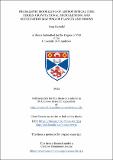Probabilistic modelling of astrophysical time series : gravitational microlensing and occultation mapping of planets and moons
Abstract
Progress in astronomy in the 21st century is contingent on the ability to extract useful information from complex and noisy datasets. This requires modeling the data-generating process – a complex combination of the physical phenomenon of interest and the “noise”. The goal is to create an approximate model that captures the essence of this process and then fit it to the data. This thesis covers the development of new methods and tools for almost all aspects of the data analysis process in two fields of astronomy: gravitational microlensing and occultation/eclipse mapping. In both fields, the objective is to infer the physical properties of exoplanets, stars, or dark compact objects by measuring the brightness variations of a light source as a function of time. Building on recent advancements in statistics, machine learning, and computer science, I developed a new open-source package called caustics for computing the microlensing magnification in single, binary, and triple-lens microlensing events. I also tackled foundational questions on the statistical analysis of single-lens and multiple-lens microlensing events, developing a new paradigm for modeling degenerate single-lens microlensing events and demonstrating the flaws of commonly used methods for analyzing multiple-lens microlensing events. Moreover, I built models for reconstructing two-dimensional emission maps of spherical bodies, exoplanets, and Solar System objects from one-dimensional photometric occultation light curves. Together with collaborators, I developed a novel method for reconstructing spatial maps of volcanic emission on Jupiter’s moon Io from occultation light curves and used the same method for exoplanet eclipse mapping to explore the possibility of detecting weather and climate change on Hot Jupiters using simulated photometric JWST secondary eclipse light curves.
Type
Thesis, PhD Doctor of Philosophy
Collections
Except where otherwise noted within the work, this item's licence for re-use is described as Creative Commons Attribution 4.0 International
Items in the St Andrews Research Repository are protected by copyright, with all rights reserved, unless otherwise indicated.


